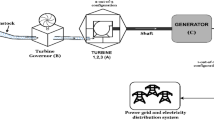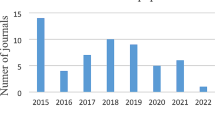Abstract
From 1995–1999 a R&D project on fuzzy control applications to the Belgian Reactor 1 (BR1) was conducted at the Belgian Nuclear Research Centre (SCK·CEN). Due to the safety regulations of the nuclear reactor, it is not realistic to perform many experiments at BR1. In this situation, part of the pre-processing experiments had to be carried outside the reactor (e.g., comparisons of different methods and the preliminary choices of the parameters). Therefore a water-level control system, referred to as a real-time control demo-model, was designed and constructed. In this paper, the construction of the demo-model and related hardware aspects is firstly outlined, then the results of a fuzzy control (Mamdani-type) and an adaptive fuzzy control are presented. The adaptive fuzzy control is a fuzzy control with an adaptive function that can self-regulate the fuzzy control rules. Finally, an implementation of a computer simulation is introduced with an adaptive fuzzy control for this real-time control demo-model.
Similar content being viewed by others
References
Zadeh, L. A. 1965. Fuzzy sets. Information and Control 8(3); 338-353.
Ruan, D., and van der Wal, A. J. 1998. Controlling the power output of a nuclear reactor with fuzzy logic. Information Sciences 110; 151-177.
Li, X., and Ruan, D. 1997. Constructing a fuzzy logic control demo model at SCK' CEN. In Proceedings of the 5th European Congress on Intelligent Techniques and Soft Computing. Aachen, Germany, 1408-1412.
Ruan, D., and Li, X., 1998. Fuzzy-logic control applications to the Belgian Reactor 1 (BRl). Computers and Artificial Intelligence 17(2-3); 127-150.
Omron. 1992. C200H-FZfJOl Fuzzy Logic Unit, Operation Manual. Omron company.
Batur, C., and Kasparian, V. 1991. Adaptive expert contro!. International Journal of Control 54(4); 867-881.
Tonshoff, H. K., and Walter, A. 1994. Self-tuning fuzzy-controller for process control in internal grinding. Fuzzy Sets and Systems 63; 359-373.
Berenji, H. R., and Khedkar, P. 1992. Learning and tuning fuzzy logic controllers through reinforcements. IEEE Trans. Neural Networks 3; 724-740.
Halgamuge, K., and Glesner, M. 1994. Neural networks in designing fuzzy systems for real world applications. Fuzzy Sets and Systems 65; 1-12.
Jang, J. S. R. 1992. Self-learning fuzzy controllers based on tempora1 back propagation. IEEE Trans. Neural Networks 3(5); 714-723.
Kosko, B. 1992. Fuzzy Systems and Neural Networks. Englewood Cliffs, NJ; Prentice-Ha1!.
Lin, C. T., Lin, C.J., and Lee, G. C. S. 1995. Fuzzy adaptive learning control network with on-line neural learning. Fuzzy Sets and Systems 71; 25-45
Takagi, H., and Hayashi, I. 1991. NN-driven fuzzy reasoning. International Journal of Approximate Reasoning 5; 191-212.
Wang, L. X., and Mendel, J. M. 1992. Generating fuzzy rules by learning from examples. IEEE Trans. Systems. Man and Cybernetics 22; 1414-1427.
Lim, M. H. Rahardja, S., and Gwee. B. H. 1995. A GA paradigm for learning fuzzy rules. Fuzzy Sets and Systems 82; 177-186.
Qi, X. M., and Chin, T. C. 1997. Genetic algorithms based fuzzy controller for high order systems. Fuzzy Sets and Systems 91; 279-284.
He, S. Z., Tan, S. H., Hang, C. C., and Wang, P. Z. 1993. Control of dynamical processes using an on-line rule-adaptive fuzzy control system. Fuzzy Sets and Systems 54; 11-22.
Li, X., Bai, S., and Zhang, Z. 1996. An introduction to a fuzzy adaptive control algorithm. Chinese Journal of Advanced Software Research 3(1); 1-11.
Procyk, T. J., and Mamdani, E. H. 1979. A linguistic self-organizing process controller. Automatica 15(1); 15-30.
Shao, S. 1988. Fuzzy self-organizing controller and its application for dynamic processes. Fuzzy Sets and Systems 26; 151-164.
Tanscheit, R., and Scharf, E. M. 1988. Experiments with the use of a rule based self-organizing controller for robotic applications. Fuzzy Sets and Systems 26; 151-164.
Wu, Z. Q., Wang, P. Z., Teh, H. H. and Song, S. S. 1992. A rule self-regulating fuzzy controller. Fuzzy Sets and Systems 47; 13-21.
Chung, B. M., and Oh, J. H. 1993. Control of dynamic systems using fuzzy learning algorithm. Fuzzy Sets and Systems 59; 1-14.
Li, X, and Ruan, D. 1998. Comparative study of fuzzy control, PID control, and advanced fuzzy control for simulating a nuclear reactor operation. In Proceedinds of the 3rd International FUNS Workshop. Antwerp, Belgium, 424-434.
Ruan, D., and Van den Eynde, G. 1999. Adaptive fuzzy control for simulating a nuclear reactor operation. In Proceedinds of the 13th European Simulation Multiconference. Warsaw, Poland, 311-315.
Jansen, W. J., Venema, R. S., ter Brugge, M. H., Diepenhorst. M, Nijhuis, J. A. G., and Spaanenburg, L. 1995. Stability properties of fuzzy controllers. Benelux Quarterly Journal on Automatic Control, 36(3); 2737.
Author information
Authors and Affiliations
Rights and permissions
About this article
Cite this article
Ruan, D. Implementation of Adaptive Fuzzy Control for a Real-Time Control Demo-Model. Real-Time Systems 21, 219–239 (2001). https://doi.org/10.1023/A:1011180104228
Issue Date:
DOI: https://doi.org/10.1023/A:1011180104228




